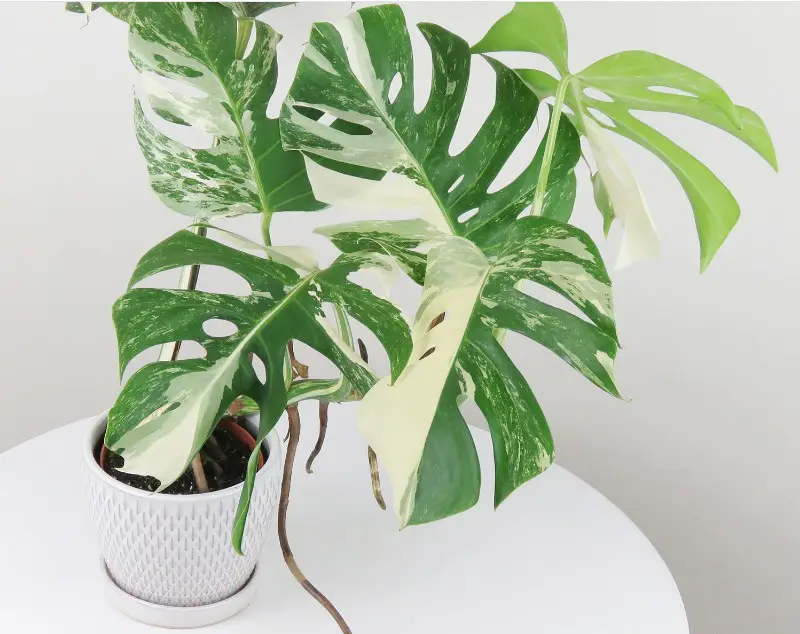The Monstera albo (scientific name Monstera deliciosa ‘Albo Borsigiana’) is a rare, highly sought-after plant that has captivated plant enthusiasts worldwide. Known for its breathtaking white variegation on split leaves, this plant is a popular choice despite its high cost, with prices ranging from hundreds to thousands of dollars.
Let’s dive into a comprehensive guide on caring for this striking plant, addressing everything from light requirements to propagation techniques and common challenges.
Overview of Monstera Albo

The Monstera albo belongs to the Araceae family and is a variegated variety of the Monstera deliciosa. This plant is distinctive for its natural white and green marbling, making each leaf unique. Its stunning appearance, combined with its exclusivity, makes it a prize among plant collectors. Native to Central America’s tropical rainforests, it flourishes in conditions with indirect sunlight, high humidity, and well-draining soil.
Key Characteristics:
- Common Names: Monstera albo, Variegated Monstera
- Botanical Name: Monstera deliciosa ‘Albo Borsigiana’
- Size: Reaches up to 10 feet indoors; 30 feet outdoors in tropical environments
- USDA Hardiness Zones: 9-11
- Toxicity: Toxic to pets due to calcium oxalate crystals
Essential Monstera Albo Care Requirements
While caring for a Monstera albo can be challenging, following the proper guidelines will help it thrive. Here’s what you need to know about keeping your Monstera albo healthy and vibrant.
Light Requirements
Monstera albos need bright, indirect light to maintain their variegation. Aim to provide six to seven hours of filtered sunlight daily. Direct sunlight can burn the leaves, particularly the white parts, which are more sensitive due to the lack of chlorophyll. Insufficient light can cause the plant to lose its variegation, so avoid low-light conditions. Using a grow light can be helpful if natural light is limited.
Ideal Soil Mix
A well-draining soil mix is crucial for Monstera albo as it reduces the risk of root rot. You can create an ideal mix by combining equal parts perlite, orchid bark, coco coir, and coco peat. Adding organic fertilizers like worm castings enriches the soil with nutrients that enhance growth and foliage health. The soil should be slightly acidic to neutral, with a pH of 5.5 to 7.
Watering Routine
This tropical plant prefers consistent moisture, but overwatering can lead to root rot. Let the top 1-2 inches of soil dry out between waterings, and ensure that the pot has drainage holes to prevent water accumulation. Water thoroughly, allowing excess water to drain, then wait until the top layer dries out before the next watering session.
Temperature and Humidity
To mimic its tropical origins, keep your Monstera albo in temperatures between 65 and 80°F. This plant thrives in high humidity—aim for at least 60%. If household humidity is low, use a humidifier, group your plants, or place it in a humid room like a kitchen or bathroom.
Fertilizing for Variegated Foliage
Since Monstera albo has variegated leaves, it benefits from regular feeding to support growth. Feed it with a balanced liquid fertilizer once a month during spring and summer. Avoid over-fertilizing, as it can damage the plant. Discontinue fertilizing in fall and winter when the plant enters its dormant phase.
Common Types of Monstera Albo
Monstera albo comes in a few beautiful variations. Each has its unique leaf shape and variegation pattern:
- Monstera deliciosa ‘Albo Variegata’: Features deep green leaves with creamy white patches.
- Monstera adansonii ‘Albo Variegata’: Rare, with multiple fenestrations and green-and-cream coloration.
- Monstera deliciosa ‘Albo Borsigiana’: Known for its large, primarily white leaves with green markings.
- Monstera Marbled Albo: Rarest, showcasing a marbled appearance with unique green-and-white splotches.
Propagating Monstera Albo
Propagating Monstera albo is possible through stem cuttings. Here’s a step-by-step guide:
- Select a healthy stem with at least one to three nodes.
- Trim away the lower leaves, exposing the nodes at the bottom.
- Choose a rooting medium (sphagnum moss, water, leca, or perlite).
- Prepare your medium, ensuring it remains consistently damp throughout the rooting process.
- Place the cutting so that the exposed nodes are submerged, but the leaves are above the surface.
- Keep the cutting in bright, indirect light, and maintain moisture in the rooting medium. In a few weeks, roots should start forming.
- Transplant once roots are 2-3 inches long, using a well-draining potting mix.
Potting and Repotting Monstera Albo
Due to its slow growth rate, Monstera albo usually requires repotting every two to three years. Repot in spring or summer, avoiding the fall and winter dormancy period. Choose a pot that’s one size larger, remove old soil from the roots, and add fresh soil to help rejuvenate the plant.
Pruning Tips for Monstera Albo
Pruning isn’t required frequently but can help manage growth and keep the plant healthy. Remove any yellow, dying leaves and prune above growth nodes. Always use sanitized tools to avoid disease spread, and water thoroughly after pruning.
Common Issues with Monstera Albo
While Monstera albo is generally hardy, it can experience several problems. Here’s how to address them:
- Drooping Leaves: Can indicate overwatering, root rot, or shock. Check soil moisture and ensure the plant has acclimated to its environment.
- Yellow Leaves: Often a sign of overwatering, lack of light, or improper fertilization. Review your watering and light setup.
- Loss of Variegation: Caused by insufficient light. Increase light exposure to bring back variegation.
- Brown Patches: Due to low humidity, underwatering, or sunburn. Increase humidity or adjust watering habits.
Pests and Plant Diseases
The Monstera albo is susceptible to common pests like spider mites, mealybugs, fungus gnats, and thrips. Regularly inspect your plant and apply insecticide as needed to prevent infestations.
Encouraging Monstera Albo to Bloom
Seeing a Monstera albo bloom is a rarity, especially indoors. However, you can promote flowering by providing bright light, warm temperatures, and high humidity (60-80%). Using a greenhouse setup can help, though it’s primarily the foliage that attracts most collectors.
Final Thoughts
The Monstera albo is an exquisite addition to any plant collection, with its unique white and green leaves adding elegance to any room. While it may require a bit more attention, this guide covers all the essential steps to maintain a healthy Monstera albo and enjoy its beauty for years to come.






